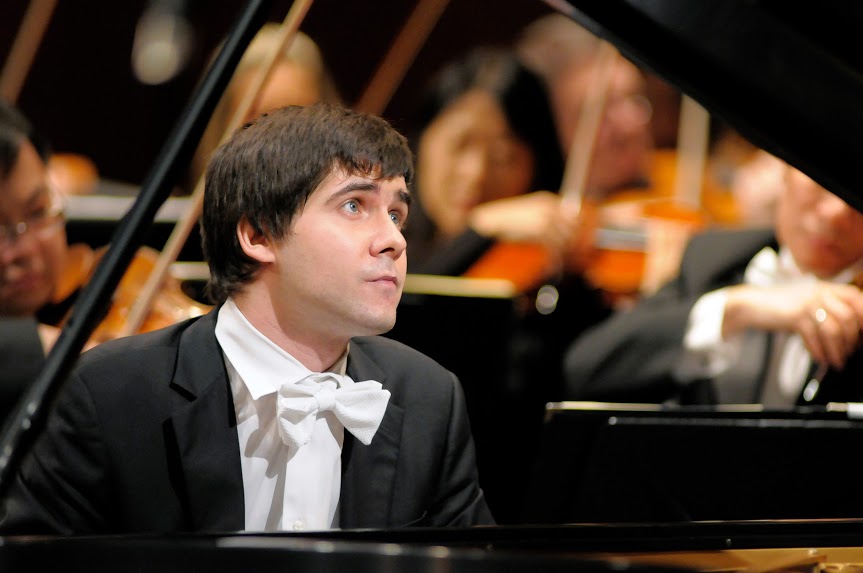One of the best new things in Fort Worth for the 2014-15 concert season has been the arrival of 2013 Cliburn gold medalist Vadym Kholodenko as officially designated “Artistic Partner” with the Fort Worth Symphony. Fort Worth has a great track record for attracting Cliburn medalists — and a smattering of other major pianistic superstars, including Van Cliburn himself and Lili Kraus — to settle in the city permanently, and Kholodenko, now in residence with his wife and two young children, is definitely in Cowtown for the foreseeable future.
The major component of Kholodenko’s artistic partnership with the orchestra is a multi-year live performance and recording project, planned to encompass all five of the piano concertos of Sergei Prokofiev — a body of work which includes, along with three immensely popular works, two neglected and virtually unknown concertos. This will give both the orchestra and the local audience a chance to interact with the pianist and to expand in terms of musical exposure, while, hopefully, providing an equally beneficial relationship for Kholodenko.
Thursday night, with the techno-posh Renzo Piano Pavilion at the Kimbell Art Museum as a venue, Kholodenko and the orchestra further enriched their relationship with a chamber music concert featuring two trios of Brahms and one trio of Poulenc. Kholodenko performed on all three works, while six musicians from the orchestra joined him in the configurations demanded by the repertoire. Ukrainian-born, Moscow-trained Kholodenko has already proven himself a worthy heir of the great Russian blood-and-thunder tradition of virtuoso pianism; as in his performance during the Cliburn Competition, he demonstrated, in this concert, the ability to collaborate on the intimate, one-on-one level of chamber music as well. While a gigantic ego is necessary for the solo recitalist or concerto soloist, it can be deadly, artistically speaking, in a chamber music situation; though he drew the bulk of the heavy lifting for the evening, Kholodenko consistently applied his remarkable technical skills as part of a cooperative effort.
Brahms’ late-in-life Trio in A minor for Clarinet, Cello, and Piano, Opus 114, opened the concert with an almost sorrowfully autumnal mood; clarinetist Ana Victoria Luperi and cellist Allan Steele provided a striking interplay and obviously deliberate matching of timbres between the cello and piano, particularly noticeable in the delicate scale passage of the closing theme of the first movement. Brahms indulged in some late-in-life rage at fate in the outer movements; the high point for this listener, however, arrived with the complex, dark third movement, wherein not even the shift from A minor to A major significantly brightened the over-all aura. The second movement, meanwhile, at times resembling a lied for clarinet, showed off clartinetist Luperi’s wonderful tone and control particularly well.
Oboist Jennifer Coming Lucio and bassoonist Kevin Hall joined Kholodenko for Poulenc’s Trio for Oboe, Bassoon, and Piano, a sort of French cousin to Prokofiev’s Symphony No. 1. The French composer’s witty neo-classicism borders at times on satire of the classical style, most obviously in the pseudo-heroic introduction that quickly gives way to the body of the rollicking opening movement. Throughout this three-movement work, the beautiful blending of Hall’s bassoon and Lucio’s oboe (emphasized in Poulenc’s penchant for parallelisms and unison octaves for the two instruments) was nicely complemented with Kholodenko’s luxuriant piano tone.
Having tasted late-period Brahms at the opening of the concert, listeners experienced the mid-life vigor and almost symphonic breadth of that composer’s Trio in E-flat for Horn, Violin, and Piano, Opus 40, with violinist Michael Shih and Kelly Cornell from the horn section here joining Kholodenko. The Scherzo second movement inspired the most dramatic gestures from Brahms, allowing the horn to burst into full open-air glory against soaring violin melodies, while the Finale echoed the galloping, march-like energy of the Finale of the composer’s slightly earlier piano quintet.
With a number of events in the collaboration between Kholodenko and the Fort Worth Symphony still ahead, the partnership has begun quite promisingly, with the likelihood of a profoundly positive effect on the local musical community.





